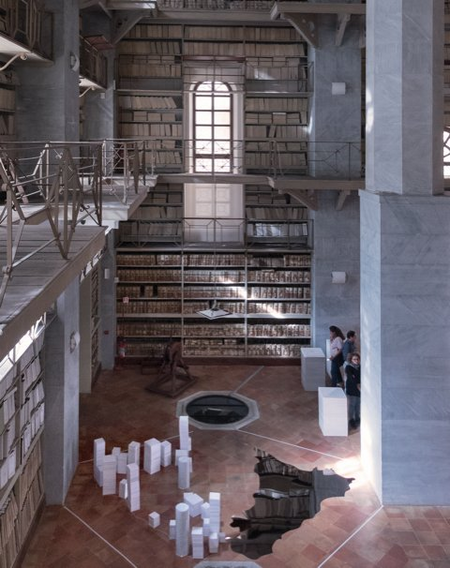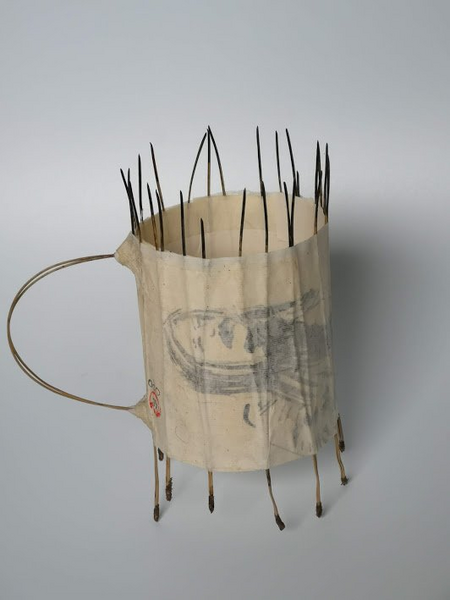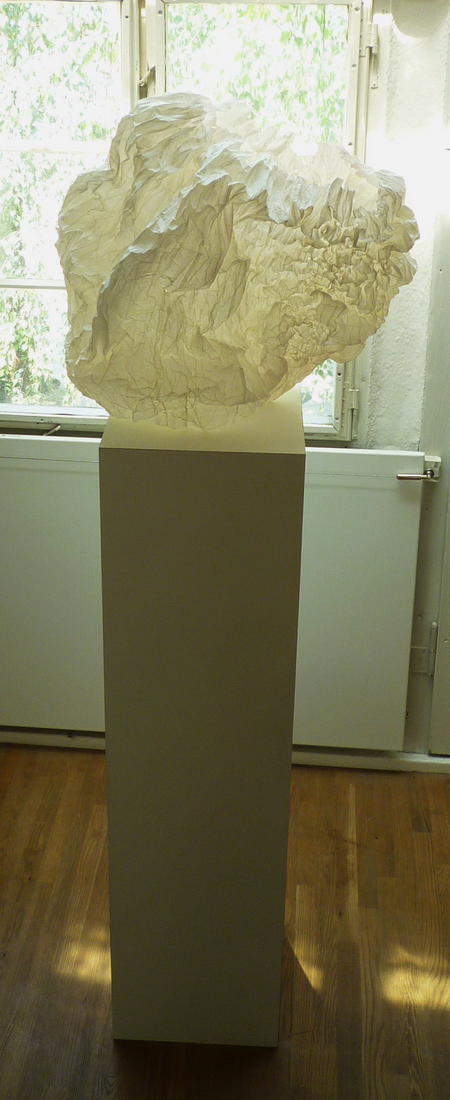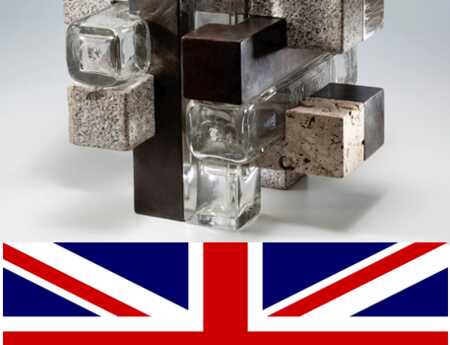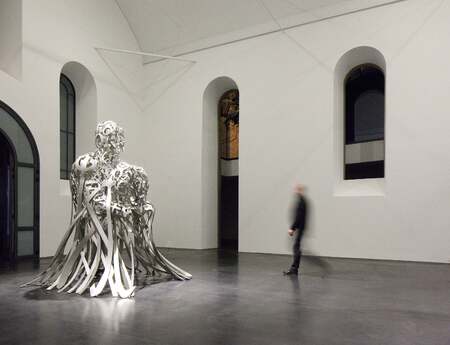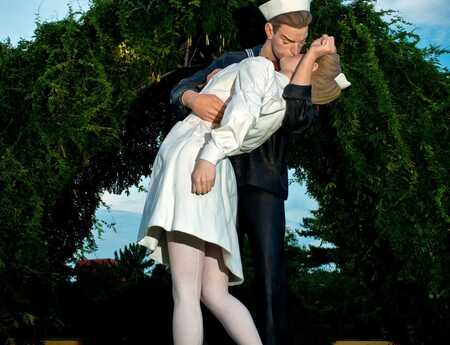PAPER - from light and delicate to voluminous and angular
Paper is an object which, due to its everyday presence and through an often thoughtless usage, nearly thwarts its potential for exciting works of art. Sculpture network presents six artists who use paper to create interesting works in a variety of forms.
Paper (lat. papyrus) consists primarily of plant fibers. Originally it was made from papyrus which gave paper its name, but ingredients from rice, straw, bamboo, and silk plants have also been used. The invention of paper replaced earlier writing surfaces made of clay, wax, bone and other animal products, stone, metal, or parchment. In this sense, paper is a material that has been in use for a very long time. The earliest found paper was used in China around 100 AD. The production of these first papers was complex and expensive. Not until the 19th century was paper as a material, to a large extent, industrially manufactured. This development made information and education accessible to a wider section of the population.
Nowadays, the production of paper (and also of cardboard and other paper products) is strongly industrialized, with the exception of special handmade or artist papers. As a general rule, wood fibers (cellulose) and waste paper are used as base material. In addition to this, various fillers, wet-strengthening agents, binding and brightening agents, or coloring agents as well as agents to increase the resistance to aging are added. The weight/thickness of the sheets is determined and then the smoothness of the surface is adjusted for later use by adding glue. Papers can also be further processed, provided with additional materials to conquer new areas of application (e.g. Tetra Pack). The basic substances are mixed in large vats, from which the fiber pulp produced from the raw materials is taken, strained, and dried on long belts between several rollers. This process is responsible for the direction of the fibers and thus the grain of the paper (recognizable by the crack formation while tearing a sheet).
Paper today is an everyday object, seen by many either as a pure transmitter of information, or as packaging that occupies a lower rank than that of what is to be protected. Despite digitalization, a large amount of paper and cardboard is still produced. Today, paper is an industrial mass product and is considered a cheap raw material. Many paper products become waste after a single use.
Paper in art
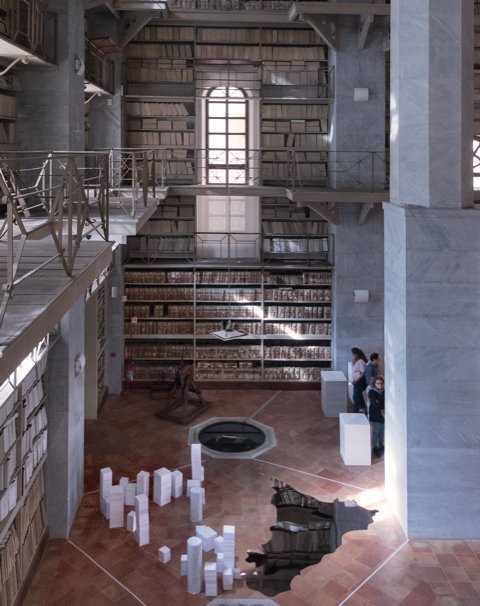
metal, paper, sound, steel, 85 x 150 x 300 cm
The material can be used in many ways for artistic purposes. It can be folded, glued, pasted, printed, collaged, cut, painted, dyed, perforated, torn, punched, embossed, bent, and drawn upon. Combinations of several actions can also occur. Thus, artists can create silhouettes and shadow plays, folds and origami, or use paper as a painting and drawing ground, for prints and engravings, for artist books and room-sized installations. In many cases, paper is also a (lower ranking) surface material in art. Furthermore, the material is to a certain extent capable of imitating other materials, such as marble, leather and wood, visually and purely externally.
Generally speaking, works of art made on or of paper are durable over very long periods of time, provided that external influences such as moisture or high heat/fire do not occur. However, it must be said that not all papers are resistant to ageing, paper works of art can be easily damaged, destroyed, or burned (including burning books), and water softens and dissolves them.
In the following, six artists are introduced who create interesting and diverse works from paper.
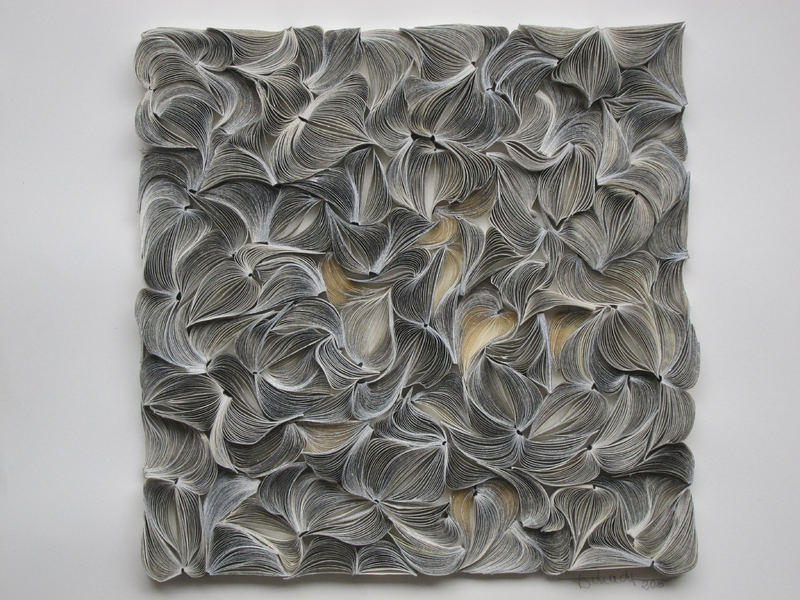
Helene Tschacher originally comes from the craft of bookbinding and as an artist, the book is of great importance to her. Her works always deal with the general statement of a book as a carrier of knowledge and information. Thus she says about her works that, "at first, only important information was recorded in writing on paper and when books became more widespread, the education that came with them was easier for people to reach". For her work Gödel, Escher, Bach, Tschacher is cutting and sawing "old" books and is rearranging them with exact geometric precision. The information originally contained in these books is still present, but due to the editing it is no longer readable. Her works include questions of truth about the no-longer-visible information, as well as the question of the changeability of information to "fake news", and about the absolute, especially in the digital media. The title of the used book is therefore always the title of the work. Equally important for the artist is the reference to the significance of the paper and the new objects created from it. For her works, she uses what is already in use, in the eyes of some perhaps also used up, which is usually perceived as "simply there", thus Tschacher's art also incorporates her view of the overexploitation of nature. Her works are very aesthetically structured and serial, so that the multiples are repeatable, but always have their own characteristics and slight differences.
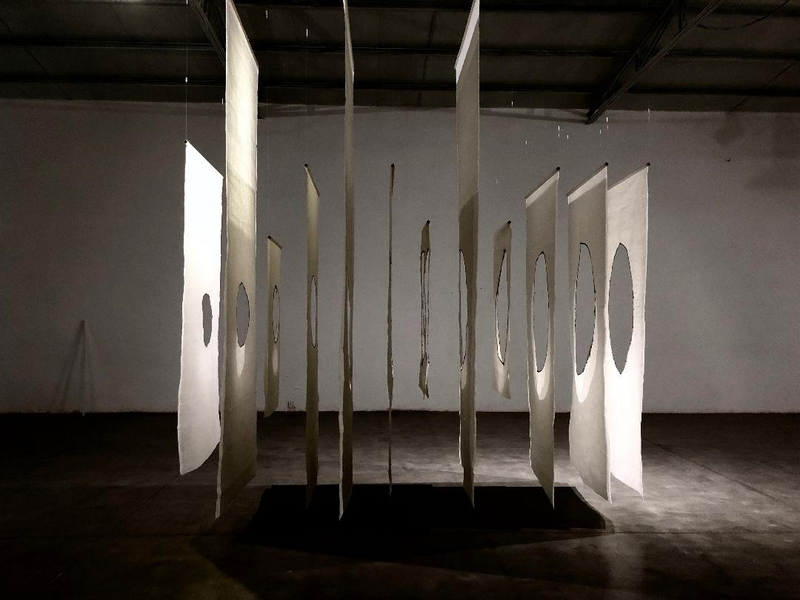
In her work Maybe the Void, the artist Mireya Samper addresses the fragility of nature and, in general, the fragility of emptiness. The work describes man's immersion in nature and how it is changed. Just as emptiness can no longer represent ”emptiness" through penetration, in nature too, a change of the original natural space occurs through the introduction of man. If these influences happen in excess, destruction can be triggered. The artwork is also implemented so that it shows itself differently through a change in the observer's point of view, just as the perspectives on the natural spaces can change. The works of Samper are mainly made of thin Japanese paper. For the artist, the "quiet presence, the simplicity and the light it radiates" is an essential part of the work. For her, paper is an excellent material to create light and delicate yet voluminous works due to the many "possibilities of intervention". With the work Maybe the Void, the artist succeeds in creating a three-dimensional work with large installations of light, thin two-dimensional layers. The "emptiness" so to speak, is worked out of thin layers of paper. The work appears in its design as a representative of one's own emptiness that can be projected into the interior of the work.
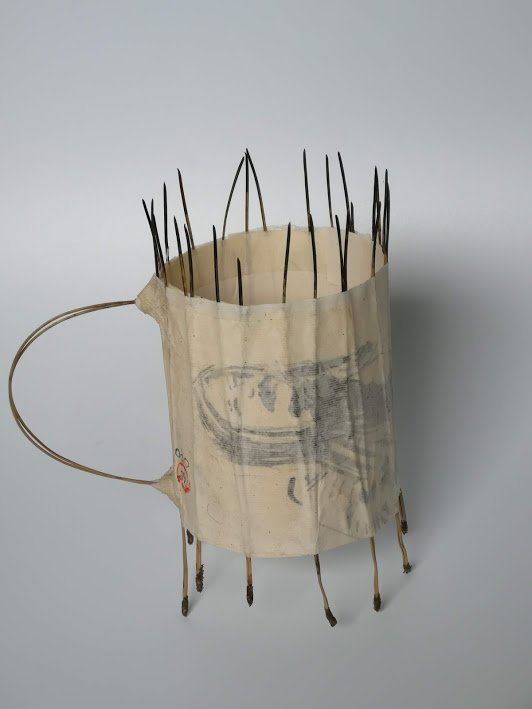
Jūra. A. Vaškevičiūtė, "Thirsty", 2019,
mixed media,natural material, paper,
21 x 10 x 18 cm
In the works of Jūra. A. Vaškevičiūtė, the exploitation of the earth and the complete exhaustion of its resources is a central theme. Also inscribed are the thoughts on environmental protection and what mankind returns to nature as garbage and dirt. The work of Vaškevičiūtė encourages reflection on one's own behavior and points out what every human being wants to leave to their descendants, or what will no longer exist through exploitation. In her work Thirsty, the artist reflects the fragility of earth’s natural and ecological system and alludes to the current zeitgeist of "always wanting more" and the ruthless wastefulness of today's generations. The container, which stands on many thin legs, reminds one, also because of its "handle" attached to one side, of a vessel which, however, has several small holes in the raised base, so that its contents, can run out again. Only coarser remnants could remain in the vessel, be collected and used again. However, any remnants that remain are difficult to get out of the container, as it also has many thin and sharply protruding metal projections on the upper side. The work Thirsty in its form as a container thus counteracts itself and symbolizes the eternal thirst for new and ever more.
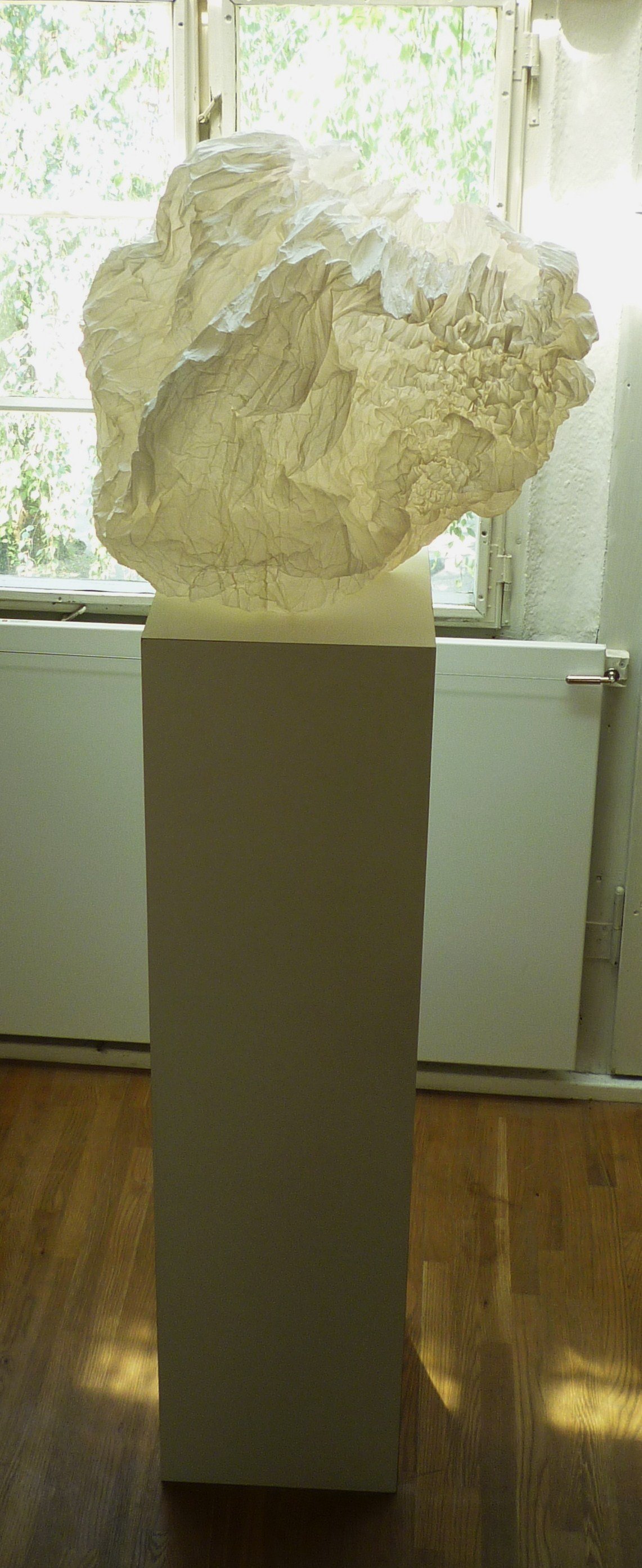
Sibylle Nestrasil, "Missgunst",
silk paper, pastemix,
43 x 38 x 32 cm
The paper object Missgunst (resentment) by Sibylle Nestrasil is one of the seven deadly sins which is confronted, in a series, with the seven virtues. The 14 objects in this series are created from identical initial forms. While the virtues signal an expansion and thus trust, the objects illustrating the sins are contracted and rigid, symbolizing fear. For the artist, paper is a versatile material that can be worked and designed in many different ways. With this medium, a multitude of expressions can be communicated in a work of art with ever new possibilities. Thus, in juxtaposing the series of virtues against the sins, it is easy to see how an identical initial medium and an identical initial form can be designed to create completely different objects. In the individual works of the series "Deadly Sins" and "Virtues", the artist succeeds in creating an outstanding combination of unbelievably light and translucent yet compact and voluminous pieces. The work appears cloudy and soft yet, to a certain extent, threatening from its high viewpoint. At the same time, it is unclear whether the "deadly sins" can spread to the viewers themselves, leaving them rigid and trapped in a confinement. The work reflects ideas, norms and rules of social coexistence, the observance or non-observance of which can also be sanctioned positively or negatively by members of society.

The Buchskulptur II (book sculpture II) by Siegrid Müller-Holtz refers to the anniversary of 200 years since the birth of Theodor Fontane. For this work, the artist used old book editions by Theodor Fontane, removed most of the pages, and made the spine of the book with its stitching and, otherwise hidden, old endpapers visible anew. For Müller-Holtz, the old, worn out patina of a book and its yellowing are a valuable part of her work, as this makes the passage of time visible which should remain recognizable in the works. Important passages of text that were previously contained in the book are added again and made visible by Müller-Holtz’s handwriting. The writing, especially old manuscripts, is an important component of her works. Usually, the books retain their former shape and size. Although the artist removes and trims parts of them, the original object, is always recognizable. A major theme in the work is therefore also the recycling and upcycling of already used objects and their reuse in today's throwaway society. The individual book fragments and associated texts are carefully composed, always with the aim of supporting the former content of the book. Although the former content cannot be deciphered, the text fragments allow an insight into the stories of the used book or books. The contents of the books used in Buchskulptur II can be summarized by the theme "Fontane" and despite the use of the different book editions with texts by Fontane, they form a coherent whole.
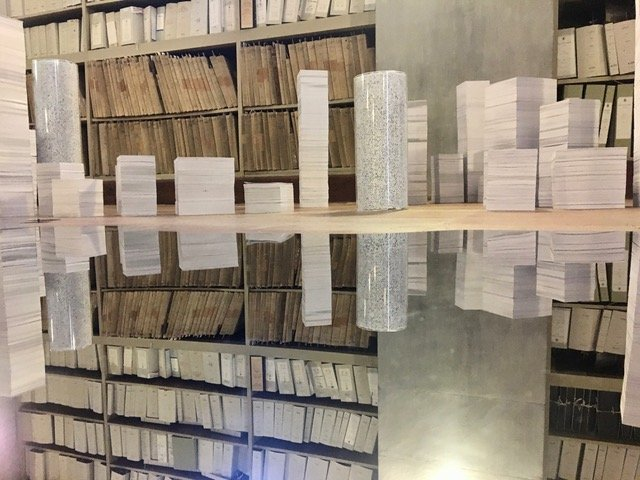
Janine von Thungen's work segni verticali e deals with the island of Sicily and its inhabitants. For her work she cut out the shape of the island from a reflective metal plate. One of the most important characteristics of an island are the lighthouses, which she formed from paper scraps from an Italian company. This company produces, among other objects, books, logbooks and diaries. Von Thüngen always includes the company's products made from these papers in the lighthouses, even if it is not obvious to the observer at first glance. This process of using scraps of paper therefore implements for the artist the wide range of hopes, expectations, fears, and memories that can be recorded in these books and are thus inscribed in the lighthouses. The lighthouse also stands for the arrival and departure of people on the island and their memories and hopes. The work of Janine von Thüngen can be seen as a reflection of the present day, as there are only a few people left who can or want to spend their whole life in one place. The hopes or fears attached to each of them are symbolically represented by the work. Through the reflective surface, the viewers find themselves inside the work. Janine von Thüngen skillfully reflects the social change from the "sedentary" to the nomad.
The works presented here give an exemplary impression of how versatile and unconventional the material paper can be when used for works of art.
More information about the artists on their homepages or sculpture network -profiles:
Helene Tschacher
Mireya Samper
Jūra. A. Vaškevičiūtė
Sibylle Nestrasil
Siegrid Müller-Holtz
Janine von Thungen
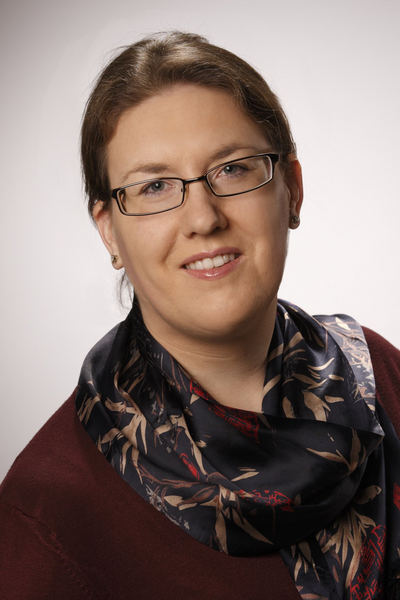
Author: Dr. Eva Daxl
Eva Daxl studied art with a focus on sculpture. In her PhD thesis she wrote about ceramic materials in art criticism. She is therefore familiar with three-dimensional works of art in theory and practice.

